Taras Kucherenko
Evaluating the evaluators: Towards human-aligned metrics for missing markers reconstruction
Oct 18, 2024Abstract:Animation data is often obtained through optical motion capture systems, which utilize a multitude of cameras to establish the position of optical markers. However, system errors or occlusions can result in missing markers, the manual cleaning of which can be time-consuming. This has sparked interest in machine learning-based solutions for missing marker reconstruction in the academic community. Most academic papers utilize a simplistic mean square error as the main metric. In this paper, we show that this metric does not correlate with subjective perception of the fill quality. We introduce and evaluate a set of better-correlated metrics that can drive progress in the field.
Towards a GENEA Leaderboard -- an Extended, Living Benchmark for Evaluating and Advancing Conversational Motion Synthesis
Oct 08, 2024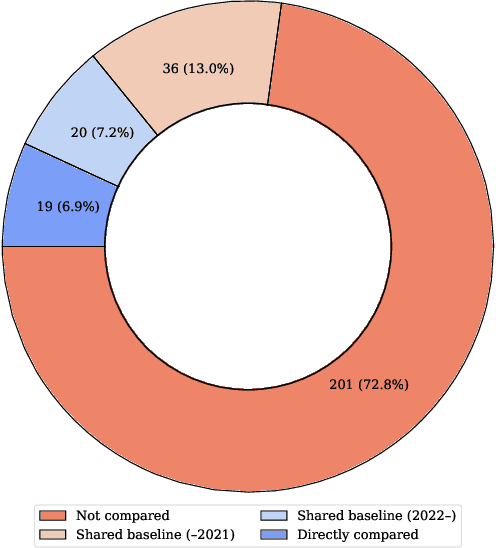

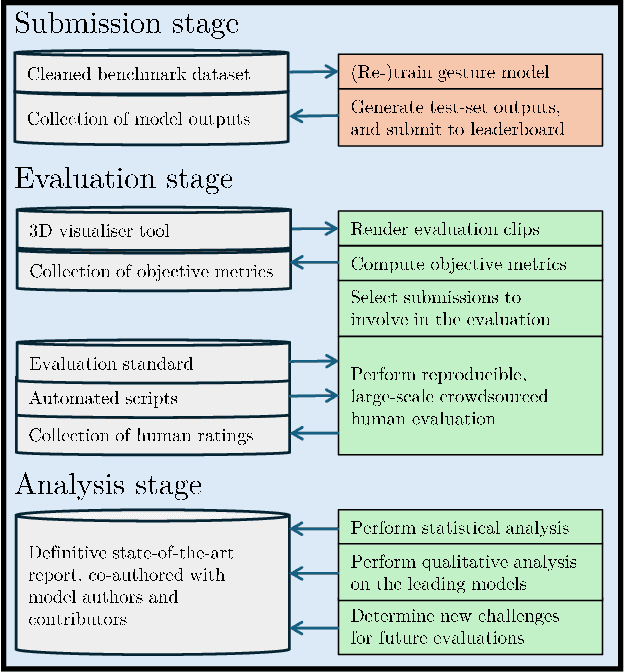

Abstract:Current evaluation practices in speech-driven gesture generation lack standardisation and focus on aspects that are easy to measure over aspects that actually matter. This leads to a situation where it is impossible to know what is the state of the art, or to know which method works better for which purpose when comparing two publications. In this position paper, we review and give details on issues with existing gesture-generation evaluation, and present a novel proposal for remedying them. Specifically, we announce an upcoming living leaderboard to benchmark progress in conversational motion synthesis. Unlike earlier gesture-generation challenges, the leaderboard will be updated with large-scale user studies of new gesture-generation systems multiple times per year, and systems on the leaderboard can be submitted to any publication venue that their authors prefer. By evolving the leaderboard evaluation data and tasks over time, the effort can keep driving progress towards the most important end goals identified by the community. We actively seek community involvement across the entire evaluation pipeline: from data and tasks for the evaluation, via tooling, to the systems evaluated. In other words, our proposal will not only make it easier for researchers to perform good evaluations, but their collective input and contributions will also help drive the future of gesture-generation research.
The GENEA Challenge 2023: A large scale evaluation of gesture generation models in monadic and dyadic settings
Aug 24, 2023Abstract:This paper reports on the GENEA Challenge 2023, in which participating teams built speech-driven gesture-generation systems using the same speech and motion dataset, followed by a joint evaluation. This year's challenge provided data on both sides of a dyadic interaction, allowing teams to generate full-body motion for an agent given its speech (text and audio) and the speech and motion of the interlocutor. We evaluated 12 submissions and 2 baselines together with held-out motion-capture data in several large-scale user studies. The studies focused on three aspects: 1) the human-likeness of the motion, 2) the appropriateness of the motion for the agent's own speech whilst controlling for the human-likeness of the motion, and 3) the appropriateness of the motion for the behaviour of the interlocutor in the interaction, using a setup that controls for both the human-likeness of the motion and the agent's own speech. We found a large span in human-likeness between challenge submissions, with a few systems rated close to human mocap. Appropriateness seems far from being solved, with most submissions performing in a narrow range slightly above chance, far behind natural motion. The effect of the interlocutor is even more subtle, with submitted systems at best performing barely above chance. Interestingly, a dyadic system being highly appropriate for agent speech does not necessarily imply high appropriateness for the interlocutor. Additional material is available via the project website at https://svito-zar.github.io/GENEAchallenge2023/ .
Evaluating gesture-generation in a large-scale open challenge: The GENEA Challenge 2022
Mar 15, 2023Abstract:This paper reports on the second GENEA Challenge to benchmark data-driven automatic co-speech gesture generation. Participating teams used the same speech and motion dataset to build gesture-generation systems. Motion generated by all these systems was rendered to video using a standardised visualisation pipeline and evaluated in several large, crowdsourced user studies. Unlike when comparing different research papers, differences in results are here only due to differences between methods, enabling direct comparison between systems. The dataset was based on 18 hours of full-body motion capture, including fingers, of different persons engaging in a dyadic conversation. Ten teams participated in the challenge across two tiers: full-body and upper-body gesticulation. For each tier, we evaluated both the human-likeness of the gesture motion and its appropriateness for the specific speech signal. Our evaluations decouple human-likeness from gesture appropriateness, which has been a difficult problem in the field. The evaluation results are a revolution, and a revelation. Some synthetic conditions are rated as significantly more human-like than human motion capture. To the best of our knowledge, this has never been shown before on a high-fidelity avatar. On the other hand, all synthetic motion is found to be vastly less appropriate for the speech than the original motion-capture recordings. We also find that conventional objective metrics do not correlate well with subjective human-likeness ratings in this large evaluation. The one exception is the Fr\'echet gesture distance (FGD), which achieves a Kendall's tau rank correlation of around -0.5. Based on the challenge results we formulate numerous recommendations for system building and evaluation.
A Comprehensive Review of Data-Driven Co-Speech Gesture Generation
Jan 13, 2023Abstract:Gestures that accompany speech are an essential part of natural and efficient embodied human communication. The automatic generation of such co-speech gestures is a long-standing problem in computer animation and is considered an enabling technology in film, games, virtual social spaces, and for interaction with social robots. The problem is made challenging by the idiosyncratic and non-periodic nature of human co-speech gesture motion, and by the great diversity of communicative functions that gestures encompass. Gesture generation has seen surging interest recently, owing to the emergence of more and larger datasets of human gesture motion, combined with strides in deep-learning-based generative models, that benefit from the growing availability of data. This review article summarizes co-speech gesture generation research, with a particular focus on deep generative models. First, we articulate the theory describing human gesticulation and how it complements speech. Next, we briefly discuss rule-based and classical statistical gesture synthesis, before delving into deep learning approaches. We employ the choice of input modalities as an organizing principle, examining systems that generate gestures from audio, text, and non-linguistic input. We also chronicle the evolution of the related training data sets in terms of size, diversity, motion quality, and collection method. Finally, we identify key research challenges in gesture generation, including data availability and quality; producing human-like motion; grounding the gesture in the co-occurring speech in interaction with other speakers, and in the environment; performing gesture evaluation; and integration of gesture synthesis into applications. We highlight recent approaches to tackling the various key challenges, as well as the limitations of these approaches, and point toward areas of future development.
The GENEA Challenge 2022: A large evaluation of data-driven co-speech gesture generation
Aug 22, 2022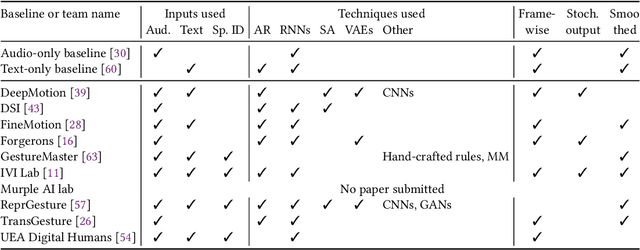
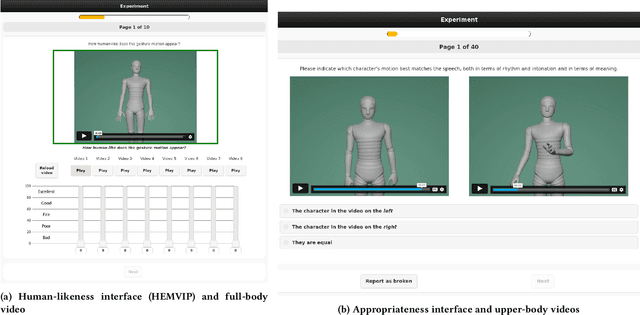


Abstract:This paper reports on the second GENEA Challenge to benchmark data-driven automatic co-speech gesture generation. Participating teams used the same speech and motion dataset to build gesture-generation systems. Motion generated by all these systems was rendered to video using a standardised visualisation pipeline and evaluated in several large, crowdsourced user studies. Unlike when comparing different research papers, differences in results are here only due to differences between methods, enabling direct comparison between systems. This year's dataset was based on 18 hours of full-body motion capture, including fingers, of different persons engaging in dyadic conversation. Ten teams participated in the challenge across two tiers: full-body and upper-body gesticulation. For each tier we evaluated both the human-likeness of the gesture motion and its appropriateness for the specific speech signal. Our evaluations decouple human-likeness from gesture appropriateness, which previously was a major challenge in the field. The evaluation results are a revolution, and a revelation. Some synthetic conditions are rated as significantly more human-like than human motion capture. To the best of our knowledge, this has never been shown before on a high-fidelity avatar. On the other hand, all synthetic motion is found to be vastly less appropriate for the speech than the original motion-capture recordings. Additional material is available via the project website at https://youngwoo-yoon.github.io/GENEAchallenge2022/
Multimodal analysis of the predictability of hand-gesture properties
Aug 12, 2021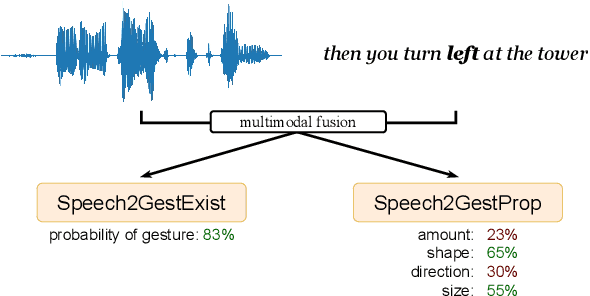

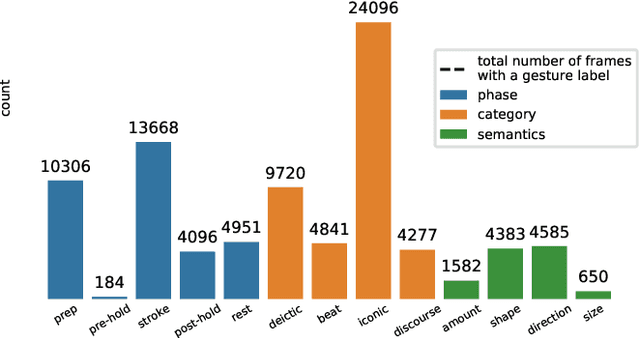

Abstract:Embodied conversational agents benefit from being able to accompany their speech with gestures. Although many data-driven approaches to gesture generation have been proposed in recent years, it is still unclear whether such systems can consistently generate gestures that convey meaning. We investigate which gesture properties (phase, category, and semantics) can be predicted from speech text and/or audio using contemporary deep learning. In extensive experiments, we show that gesture properties related to gesture meaning (semantics and category) are predictable from text features (time-aligned BERT embeddings) alone, but not from prosodic audio features, while rhythm-related gesture properties (phase) on the other hand can be predicted from either audio, text (with word-level timing information), or both. These results are encouraging as they indicate that it is possible to equip an embodied agent with content-wise meaningful co-speech gestures using a machine-learning model.
Speech2Properties2Gestures: Gesture-Property Prediction as a Tool for Generating Representational Gestures from Speech
Jun 28, 2021
Abstract:We propose a new framework for gesture generation, aiming to allow data-driven approaches to produce more semantically rich gestures. Our approach first predicts whether to gesture, followed by a prediction of the gesture properties. Those properties are then used as conditioning for a modern probabilistic gesture-generation model capable of high-quality output. This empowers the approach to generate gestures that are both diverse and representational.
A Framework for Integrating Gesture Generation Models into Interactive Conversational Agents
Feb 24, 2021Abstract:Embodied conversational agents (ECAs) benefit from non-verbal behavior for natural and efficient interaction with users. Gesticulation - hand and arm movements accompanying speech - is an essential part of non-verbal behavior. Gesture generation models have been developed for several decades: starting with rule-based and ending with mainly data-driven methods. To date, recent end-to-end gesture generation methods have not been evaluated in a real-time interaction with users. We present a proof-of-concept framework, which is intended to facilitate evaluation of modern gesture generation models in interaction. We demonstrate an extensible open-source framework that contains three components: 1) a 3D interactive agent; 2) a chatbot backend; 3) a gesticulating system. Each component can be replaced, making the proposed framework applicable for investigating the effect of different gesturing models in real-time interactions with different communication modalities, chatbot backends, or different agent appearances. The code and video are available at the project page https://nagyrajmund.github.io/project/gesturebot.
Generating coherent spontaneous speech and gesture from text
Jan 14, 2021

Abstract:Embodied human communication encompasses both verbal (speech) and non-verbal information (e.g., gesture and head movements). Recent advances in machine learning have substantially improved the technologies for generating synthetic versions of both of these types of data: On the speech side, text-to-speech systems are now able to generate highly convincing, spontaneous-sounding speech using unscripted speech audio as the source material. On the motion side, probabilistic motion-generation methods can now synthesise vivid and lifelike speech-driven 3D gesticulation. In this paper, we put these two state-of-the-art technologies together in a coherent fashion for the first time. Concretely, we demonstrate a proof-of-concept system trained on a single-speaker audio and motion-capture dataset, that is able to generate both speech and full-body gestures together from text input. In contrast to previous approaches for joint speech-and-gesture generation, we generate full-body gestures from speech synthesis trained on recordings of spontaneous speech from the same person as the motion-capture data. We illustrate our results by visualising gesture spaces and text-speech-gesture alignments, and through a demonstration video at https://simonalexanderson.github.io/IVA2020 .
* 3 pages, 2 figures, published at the ACM International Conference on Intelligent Virtual Agents (IVA) 2020
 Add to Chrome
Add to Chrome Add to Firefox
Add to Firefox Add to Edge
Add to Edge